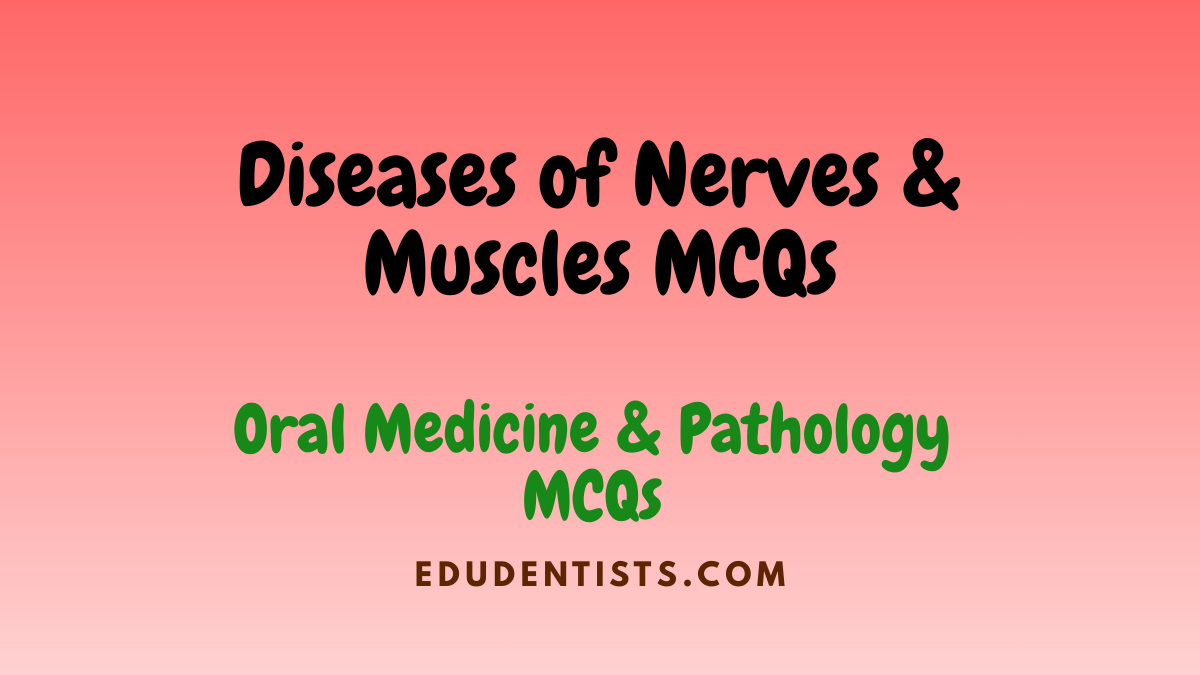Diseases of Nerves & Muscles MCQs
Diseases of Nerves & Muscles MCQs
Diseases of Nerves & Muscles MCQs
Diseases of Nerves & Muscles MCQs
- Severe pain which arise after injury to or sectioning of a peripheral sensory nerve is called as:
A. Temporal arteritis
B. Neuralgia
C. Neuritis
D. Causalgia
- Patient suffering form Eagle’s syndrome complains of:
A. burning sensations in mouth
B. excessive salivation
C. Glossodynia
D. Dysphagia
- The latest drug of the choice in the management in trigeminal neuralgia is:
A. valproic acid
B. carbamazepine
C. Diphen hydantoin
D. None of the above
- Facial paralysis is tested by:
A. Whistling
B. chewing
C. Protruding the tongue
D. Swallowing
- Which of the following structures are associated with bells palsy:
A. sub mandibular gland
B. Seventh cranial nerve
C. Temporomandibular joint
D. Glosso pharyngeal nerve
- If a patient with Raynaud’s disease puts his hand in cold water, the hand appears:
A. Red
B. Yellow
C. White
D. Blue
- Geniculate neuralgia is caused in the nerve:
A. VII
B. IX
C. X
D. II
- All of the following are true about trigeminal neuralgia EXCEPT:
A. it is unilateral
B. it is of throbbing nature
C. it is triggered by touching cheeks, mucosa etc
D. occurs in bouts
- Trotter’s syndrome involves:
A. Pharynx
B. Oropharynx
C. Larynx
D. Nasopharynx
- “Fothergill’s disease” is one of the synonyms of:
A. Sarcoidosis
B. Multiple sclerosis
C. Trigeminal neuralgia
D. Lupus erythematosis
- Lesion of facial nerve at level of stylomastoid foramen leads to:
A. Loss of taste sensation from Ant. 2/3 of tongue
B. Paralysis of orbicularis oculi muscle
C. Loss of innervation to stapedius
D. Loss of lacrimal secretion
- What is non characteristic of Eagle’s syndrome:
A. Excessive lacrimation
B. pain during mandibular movement
C. Stabbing type pain orginate in the tonsillar regions
D. When the jaws are closed the pain subsided
- Which of the following drugs is not effective in case of Trigeminal Neuralgia?
A. Carbamazipine
B. acetaminophen
C. phenytoin sodium
D. Baclofen
- Patient comes with pain pharyngeal region and is having carcinoma of nasopharynx. The diagnosis is:
A. Horner’s syndrome
B. Glossopharyngeal neuralgia
C. Trotter’s syndrome
D. Eagles syndrome
- The characteristic alarm clock headache is a feature of:
A. Auriculotemporal Neuralgia
B. Trigeminal Neuralgia
C. Sphenopalatine Neuralgia
D. Glossopharyngeal Neuralgia
- Anti-convulsants frequently used in management of trigeminal neuralgia are:
A. Phenytoin
B. Gabapentin
C. Baclofen
D. All of the above
- Which of the following Orofacial pain is not associated with vascular origin?
A. Cluster headache
B. Giant cell arteritis
C. Anaesthesia dolorosa
D. Chronic paroxysmal hemicrania
- An attack of cluster headache can be aborted by:
A. Morphine administration
B. Breathing oxygen
C. Aspirin administration
D. Sublingual nitroglycerine administration
- Burning Mouth Syndrome describes pain associated with:
A. Oral lichen planus
B. Oral submucous fibrosis
C. Aphthous stomatitis
D. No detectable oral disease
- In an acute attack of migraine, the during of choice:
A. Ergontamine tortrate
B. Methysergide
C. Propranolol
D. Caffeine
- Mask-like appearance of face with narrowing of aperture and rigidity of the mucosa is characteristic of:
A. Progressive systemic sclerosis
B. Tetanus
C. Multiple sclerosis
D. Osteomalacia
- A patient shows inability to close the right corner of the mouth is most probably suffering form:
A. Myasthenia gravis
B. Bell’s palsy
C. TMJ dysfunction syndrome
D. Multiple sclerosis
- Bell’s palsy is triggered by:
A. Exposure to cold
B. Tooth extraction
C. Local and systemic infection
D. Any of the above
- The following site is the common involvement in case of Myositis ossificans:
A. Massetor
B. Hyoglossus
C. Stylohyoid
D. Lateral pterygoid
- Trigeminal neuralgia:
A. Does not disturb the patient during sleep
B. Can be treated with NSAID’s
C. Always bilateral in distribution
D. Is a hereditary condition
- Carbamazepine has been utilized to successfully diminish attacks in trigeminal neuralgia. During this therapy which of the following is indicated:
A. Clinical observation only
B. Clinical observation and complete blood and platelet counts prior to and at frequent intervals during therapy
C. No monitoring
D. Complete blood investigation only if adverse symptoms arise
- Which syndrome consists of flushing, warmness and perspiration over the cheek and pinna of the ear on the side following the ingestion of highly seasoned food?
A. Fanconi’s
B. Auriculotemporal
C. Horner’s
D. Cushin’s
- Facial pain due to elongated styloid process is called?
A. Cowden syndrome
B. Tic doulourex
C. Eagle’s syndrome
D. Reiter’s syndrome
- A neuralgia with trigger zones in the oropharynx and pain in the ear pharynx, nasopharynx, tonsils and posterior tongue is most likely:
A. Trigeminal neuralgia
B. Bell’s palsy
C. Glossopharyngeal neuralgia
D. Sphenopalatine neuralgia
- Easy fatigability of muscles seen in:
A. Epilepsy
B. MPDS
C. Myasthenia gravis
D. Cerebral palsy
- Frey’s syndrome results from surgery of the:
A. Submandibular salivary gland
B. Parotid gland
C. sublingual salivary gland
D. TMJ
- Horner’s syndrome Does NOT include:
A. Ptosis
B. Anhydrosis
C. Flushing
D. Mydriasis
- Trigeminal heuralgia (tic doulourex) is characterized by:
A. Paralysis of one side of the face
B. Uncontrollable twitching of muscles
C. Sharp, excruciating pain of short duration
D. Prolonged episodes of plain on one side of the face
- TENS therapy is useful in:
A. MPDS
B. Trigeminal neuralgia
C. Facial palsy
D. Neurosis
- Bell’s Palsy is characterized by:
A. Bilateral involvement of the side of the face
B. Inability to whistle
C. No loss of muscular control
D. Closing of the eyes
